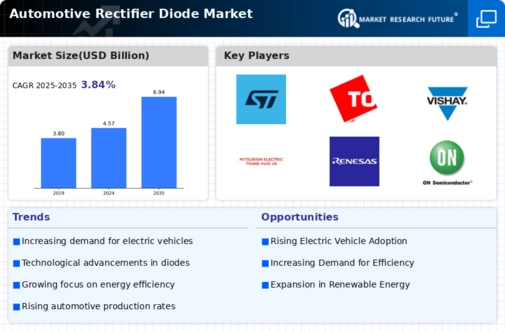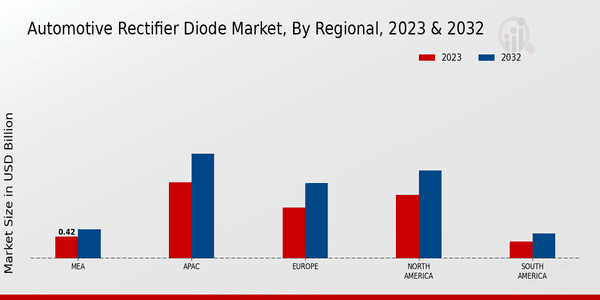Increased Focus on Fuel Efficiency
The automotive industry's heightened focus on fuel efficiency is a significant driver for the Automotive Rectifier Diode Market. As manufacturers strive to meet stringent fuel economy standards and reduce greenhouse gas emissions, the integration of advanced electronic components becomes essential. Rectifier diodes contribute to improved energy management in vehicles, thereby enhancing fuel efficiency. Recent studies indicate that vehicles equipped with optimized power electronics, including rectifier diodes, can achieve fuel savings of up to 15%. This emphasis on efficiency not only aligns with regulatory requirements but also meets consumer demand for more economical vehicles, thereby fostering growth in the rectifier diode market.
Expansion of Automotive Electronics
The expansion of automotive electronics is a crucial factor driving the Automotive Rectifier Diode Market. As vehicles become increasingly equipped with advanced electronic systems, the need for reliable power conversion components grows. Rectifier diodes are essential in various applications, including power supply units, battery management systems, and electric drive systems. The automotive electronics market is projected to reach a valuation of several hundred billion dollars in the next few years, indicating a robust demand for components like rectifier diodes. This trend suggests that as vehicles become more sophisticated, the automotive rectifier diode market will likely experience substantial growth, driven by the proliferation of electronic features.
Rising Demand for Electric Vehicles
The increasing demand for electric vehicles (EVs) is a primary driver for the Automotive Rectifier Diode Market. As consumers and manufacturers shift towards more sustainable transportation options, the need for efficient power management systems in EVs becomes critical. Rectifier diodes play a vital role in converting alternating current (AC) to direct current (DC), which is essential for battery charging and overall vehicle operation. According to recent data, the EV market is projected to grow at a compound annual growth rate (CAGR) of over 20% in the coming years. This surge in EV adoption is likely to propel the demand for automotive rectifier diodes, as they are integral components in the power electronics of these vehicles.
Regulatory Pressure for Emission Reductions
Regulatory pressure for emission reductions is a significant driver impacting the Automotive Rectifier Diode Market. Governments worldwide are implementing stringent regulations aimed at reducing vehicular emissions, which in turn encourages manufacturers to adopt cleaner technologies. Rectifier diodes are integral to the development of hybrid and electric vehicles, which are often favored under these regulations. As automakers seek to comply with emission standards, the demand for rectifier diodes is expected to increase. Market analysis suggests that the automotive sector's shift towards compliance with these regulations could lead to a substantial rise in the adoption of advanced power electronics, including rectifier diodes, thereby enhancing market growth.
Technological Advancements in Semiconductor Materials
Technological advancements in semiconductor materials are significantly influencing the Automotive Rectifier Diode Market. Innovations such as silicon carbide (SiC) and gallium nitride (GaN) diodes offer superior performance compared to traditional silicon diodes. These materials enable higher efficiency, reduced thermal management requirements, and improved reliability in automotive applications. As the automotive industry increasingly adopts these advanced materials, the demand for high-performance rectifier diodes is expected to rise. Market data indicates that the adoption of SiC and GaN technologies could lead to a reduction in energy losses by up to 50%, thereby enhancing the overall efficiency of electric and hybrid vehicles. This trend suggests a robust growth trajectory for the automotive rectifier diode sector.
















Leave a Comment